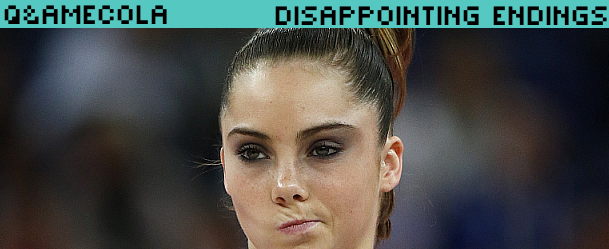They say that all good things must come to an end, but no one ever said that all good things must have a good ending. Sometimes, game developers hold this close to their hearts and offer an abysmal, awkward, or just plain atrocious ending to your favorite games. To put so many hours into a great title only to have it all fall off a cliff can be hard on the gamer. Like McKayla Maroney, sometimes we put in hours of hard work only to feel like we fell on our face at the final hour. This month, Daniel Castro asks the staff (and himself): Which game you’ve played has the worst or most disappointing ending? And there are spoilers ahead, naturally!
Oh, man! So many to choose from, from games that end up in boring or pointless conclusions, a disappointing congratulations screen, or not even having anything between the final boss and the credits roll. But there’s a game that stands out from the rest: Punch Out!!
I mean, what happened there? You bring this—literally—Little Mac onto the ring to face-off opponents way bigger and heavier than him. Little Mac defeats them all! That cheating Indian stereotype, the vodka soda drinking boxer, and even that enormous bull-rushing bald boxer with a soft belly—twice!!!
But, then Mac gets to the final match against the one and only Mike Tyson (or Mr. Dream, if you got the title’s revised version), and three uppercuts later, he’s not able to get up no matter how much you press the buttons. So, there lies the dream? No World Championship for Mac? What’s the lesson to be learned? It’s like Silvester Stallone’s Rocky, without him never getting to train Tommy Gun after becoming a bum!
What do you mean you can defeat Mike Tyson?! Yeah, suuure…what else? The Overture of Sages actually exists and you can actually catch Mew in Pokémon Red & Blue, right?
I love Fallout 3. It’s a retro-futurist post-apocalyptic sandbox action RPG with a great plot, fairly memorable characters, and great gameplay. Despite sinking many hours into Morrowind and Oblivion, it was time to check out a similar game in a new setting. It was easy to sink a lot of hours in the game with the vast side quests and conversations with characters, not to mention seeking your father. The game ends with the player pushing his father’s plans of having safe, clean, purified water available to everyone in the Washington D.C. area. Unfortunately, this also means dying in the process (or, forcing your companion to sacrifice themselves). Either way, the game ends with a lackluster slideshow of your events. You’ve probably made some important decisions that impact the lives of many. But the game simply ends there, whether you sacrifice yourself or not. In the Elder Scrolls series, you defeat the end boss, but are allowed to continue your quest, and are encourage to do so. You are the hero, but there is still much to do! Ending the game quietly is OK for regular RPGs because there isn’t anything else to do. But in open world games, there’s always more to do. Why not let me explore? Fallout: New Vegas did this as well, but at least the ending slideshow was more meaningful and heartfelt.
Yes, Fallout 3 did have a downloadable content package that extended the main story where you miraculously awaken from the now near-death episode. It does add more to do. While this is preferred, I played the game originally on the PS3, where the DLC was severely delayed. And man, why should I have to shell out additional money to have a more “complete” game?
I also hate games that don’t really have an ending, and just send you back to the beginning in a harder mode (the original Super Mario Bros., Donkey Kong, etc.).
I’m not the kind of diehard BttF fan that others around the ‘Cola are, but I do appreciate a well-told story, especially where science-fiction is involved. Normally, gameplay is the driving factor in whether or not I like a game, but what got me hooked on Back to the Future: The Game was the story. Over the course of five episodes, I wasn’t so much playing an adventure game as I was working my way through an interactive Back to the Future Part IV. And unlike with most sequels that show up a decade or two after the last installment, the story that unfolds after Doc Brown becomes marooned in his own past is one worth continuing the series for. Naturally, the chain of events sends everything pear-shaped, and it’s up to Marty McFly to zip all over Hill Valley’s history to set the timeline straight. Somehow, it all works out in the end, leading to a satisfying conclusion that—after unwrapping the closure of Back to the Future Part III—puts a nice little bow on the series once more.
Assuming you shut off the game two minutes before the credits roll.
The last part of the final cutscene unravels that bow in a matter of seconds, spends the next minute shredding the wrapping paper, and then lights the paper shreds on fire. The game makes it obvious that the developers had a sequel in mind, but I have difficulty imagining any scenario where a sequel with this particular setup isn’t a total disaster. The cliffhanger doesn’t look like the start of an exciting new game; it looks like a gag that the developers are going to regret using as the foundation for their next story, and one last chance to shoehorn in a few extra lines for special guest star Michael J. Fox. That brings up another point: At the rate Telltale makes sequels to games with nagging cliffhanger endings (five years and counting for Tales of Monkey Island), a couple of the key voice actors (including Christopher Lloyd) may not be in good enough health to reprise their roles if we ever get a sequel. Parkinson’s Disease and being born in the 1930s have a way of adding an element of uncertainty to long-term plans. I’ve played other games with hollower and dopier endings, but Back to the Future: The Game shoots itself in the foot and then goes back in time to do it again.
I remember the first time I beat Sonic Adventure 2. The closing sequence audio balance was completely out of whack, and I couldn’t hear the voices over the music. They still haven’t fixed this in subsequent releases—it’s a good job I can read, isn’t it, SAGA?
Back in the days before it was socially acceptable to admit liking anything related to Tolkien, I got my hands on the SNES Lord of the Rings Volume I game. It isn’t the worst game I’ve ever played (that honor goes to Disney’s Magic Kingdom title for the NES), nor was it really all that accurate to, well, most of the book—although, really, have you ever played anything book-accurate before? The fact that Volume II never happened might tell you something, too. Still, I enjoyed the music and had fun playing it. But the ending…oh, the ending.
If books had bosses, everyone would probably agree that the Balrog was the end boss for The Fellowship of the Ring. The fact that (spoilers) Gandalf sacrifices himself to save the others is meant to be an emotional, meaningful death for our weary friends. But in the game, you can fight the Balrog without Gandalf in your party, kill it, invite Gandalf back into your party…and the entire party strolls out of Moria and into Lothlórien. Along the way, your progress is blocked by annoying pop-up text boxes lamenting the death of Gandalf…who nonchalantly strides at the back of your party. Seriously. You need to watch his walk cycle, the wizard literally swaggers (with beard all a-waggin’) his way out of Moria due to a loophole in the game’s script.
The only really redeeming quality to the game’s ending is that it tells you to go read the books. Which you should do. Or, I don’t know, marathon the movies and then play Shadow of Mordor.
Perhaps not the worst, but definitely most disappointing (for myself, in any case), is the ending to Chrono Cross. The quest to defeat Lavos and save the future that started in Chrono Trigger continued into Chrono Cross, only instead you were defending the entire concept of reality. Meeting a cast of familiar and new characters—friends and enemies alike—you’d fight against people with increasingly alien goals before learning that your entire purpose was, again, to stop Lavos. Only this time, you were to rescue the lost princess of Zeal, Schala. However, the only way to do that was to fight a specific puzzle boss and memorize the elemental combination you used against it, then using the ultimate magic to save her and bring her back into this world. However once you accomplished this you…received the standard endings for the character arcs you completed, and then got an FMV set to a vocalized version of the game’s theme, with no indication that it was actually related to the very difficult fight you had just completed.
Is there an ending you loathe that we missed? Have a question for next month’s Q&A? Let us know below!









